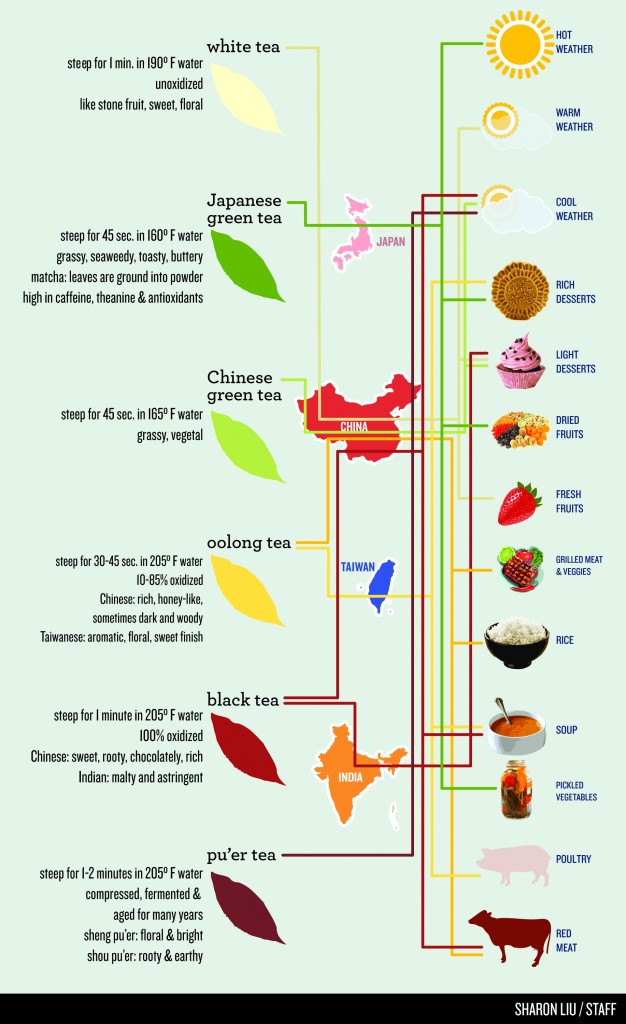
My first attempt of writing a tea guide. It was published in the special issue Food & Cuisine 2013 of the Daily Cal.
The suggested time for each category is an extremely rough estimate, because the time depends on the amount of water, the temperature of the water and the amount of tea leaves (all of this guide is of course for real, whole-leaf teas, not tea bags and not herbal teas). To complicate matters, two teas in the same category would have slightly different temperaments, just like two different people of the same ethnicity, and two teas of the same type (let’s say, Bailin Gongfu) of different years would be different and require slightly different treatment when you make the tea. Thus, how well you can make your tea almost entirely depends on experience. The good news is that how good it tastes is a matter of personal preference. 😉
With that said, for a number of reasons, this guide is not exactly what I wanted it to be. In its current form, it is a drastic oversimplification of tea. I had to cut several parts because of space limitation in print. The time crunch for publication impeded careful revisions (all communication with our graphic designer, Sharon Liu, was done via email, and to discuss graphics using only words is not a simple thing. As a result, we had to redo the infographic 4 times, and still have a pig next to “poultry” in the end). Sharon also altered my original content to simplify the design, but tea is not something so easily simplified – in fact, the moment we try to simplify teas into a few types and few-word descriptions, we get it wrong.
However, the most frustrating part is when I realized how little information there is about tea, and how scattered and discordant all of that information is. If you go to Amazon.com and type in “wine pairing”, and then type in “tea pairing”, you would see the gigantic difference between the two search results. “Tea pairing” is almost nonexistent in the literature.
Most tea books focus on the history of tea and its cultural and philosophical aspects, not on the types of tea. Teance is the only tea shop in the Berkeley-Oakland area that I can turn to for quality tea and credible information. New restaurants are adding a tea selection to their drink menu, but the selection is limited to only a few types (it’s pathetically short compared to their wine menu), the tea providers – usually big companies – misinform the restaurants about the types of tea (everyone tends to name their tea however they like it, and irresponsibly categorizes oolong teas as green teas, for example), and the wait staff has no tea training to know the difference. That is sad, especially considering how this Bay Area is known for its eagerness in developing the palate.
To make it even more confusing, herbal teas, bubble tea, milk tea, chai, etc. are called “tea”. No one would call a margarita a wine, so why do we attach the word “tea” to a lychee-flavored drink with tapioca balls?
So there we have it, two problems that a tea learner faces: 1. the word “tea” is used too nonchalantly for different things that are not tea, and 2. there is not enough information on real tea.
Why is there so little known about tea? I can only think of one reason: to drink tea, you have to know how to make tea, whereas to drink wine, you only need to know how to open the bottle.
I am currently writing an article for general beverage pairing. This info-graphic is great! Please let me know if you are opposed to me using it: I fully intend to link to your site and give credit:). I hope your tea adventures are going well!! I’m starting a “tea tour” at the end of this month–let me know if you want to join (it’s home-based–different tea tasting for each day).